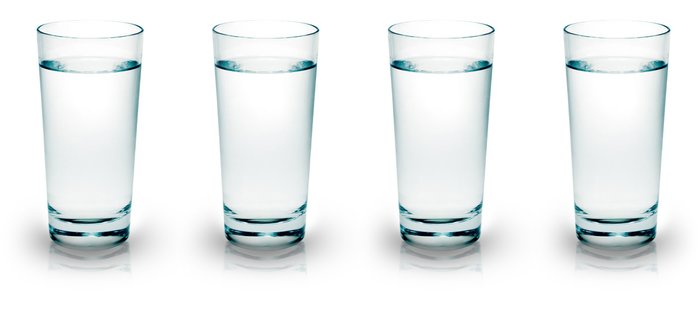Ever step on the scale only to look down in horror and think, "How can this be?" You were consistent with your training, and your nutrition was on point, but the scale is up 3 pounds! What went wrong?
More often than not, it's underestimating calorie intake or overestimating caloric burn that derails the average dieter, but you're not the average dieter. You've been tracking your food intake religiously, measuring out your portions precisely, and carefully calculating—maybe even underestimating—your daily calorie burn. All logic says you should have lost weight, but you didn't—you gained!
Before you freak out or get discouraged, let's unpack five reasons your scale weight may be inaccurate, or at least not indicative of actual fat loss or gain.
1. Your Sodium/Water Balance Is Awry
You sodium intake can significantly influence water weight. Sodium pulls water into your cells, so if you consume more sodium than normal, your body will temporarily retain water until fluid balance and sodium concentration are normalized. This can bump up your weight as much as 3.3 pounds (1.5 kilograms) according to one controlled study.[1]

Before you look back at your food journal and cut sodium completely, know this: Sodium has many vital roles such as maintaining blood volume, regulating nerve and brain function, and enabling muscle contractions. The key is to monitor your sodium intake but not cut it out completely. A minimum target for sodium is between 1,500-2,300 milligrams per day, and more if you sweat a lot during your workouts.
For example, in an hour of profuse sweating, you might lose 4 cups (1 liter) of water and 1,000 milligrams of sodium.[2] This means you need closer to 2,500-3,300 milligrams of sodium in order to replenish electrolytes.
To keep fluctuations in sodium intake from spiking your scale weight, keep your sodium intake somewhat consistent and within the healthy range for your training level. Avoid weighing yourself for a couple days if you splurge on salty processed foods and restaurant fare, since you will likely be holding on to at least a couple pounds of water weight.
2. You're Holding Waste
This should be obvious, but if you just ate a large meal or haven't had a bowel movement in a couple days, your scale weight will be high. This is why I always recommend weighing yourself first thing in the morning, fasted, after going to the bathroom.
If you're not having regular bowel movements (daily is the standard of regular), make sure you're getting 25-40 grams of fiber per day and a gallon of water daily. You might also want to try adding a daily probiotic supplement. High-fat foods, dairy products (if you're lactose-intolerant), and too much fiber can cause constipation when consumed in excess, so don't go overboard.
Some prescription pain killers, antidepressants, and blood pressure medications can also cause constipation. Stool softeners and laxative teas may offer a temporary solution, but if constipation is an ongoing issue, talk to your doctor.
3. You're Carbed up
If your carbohydrate intake was higher than normal a day—or even three days—before you stepped on the scale, your body will have stored those extra carbs as muscle glycogen.
For every gram of muscle glycogen stored in skeletal muscle, your body stores an estimated 3-4 grams of water.[3] This may seem like a small number, but it can really add up! Between your muscles and liver, the average person has the capacity to store around 500 grams of glycogen—and that's before any fat storage occurs.[4]

Let's just say you enjoyed a bunch of cake and pasta for your "treat meal" and came out at 300 grams of carbs for the day. Assuming all 300 grams of carbohydrate are stored as muscle glycogen, you just gained 1,200-1,600 grams combined glycogen and water weight, which equates to 2.6-3.5 pounds on the scale. That's all without one iota of fat storage!
Now, we're always carrying around some glycogen weight. So if you want the scale to give you a more accurate picture, plan your weigh-ins either the morning of a high-carb day (before eating), or at least four days after.
4. Your Hormones Are Punishing You
High levels of cortisol can increase sodium retention, which as we've learned, can cause water retention.[5] Many factors can lead to elevated cortisol levels, including sleep deprivation, stress, overtraining, and extreme caloric deficits.
Elevated levels of estrogen can also lead to water retention. This is why women experience bloating and water retention in the days leading up to their menstrual cycle, usually 2-5 pounds. In other words, if you're about to start your period, don't freak out if the scale shows a weight increase despite good nutrition and consistent workouts. Weigh in again next week, and everything should be back to normal.
Estrogen levels can also fluctuate during menopause due to estrogen-replacement therapy. Estradiol, a form of estrogen used to treat symptoms of menopause, has been shown to lead to weight gain due to water retention.[6]
In this case, it is better to put the scale aside and focus on nourishing your body with nutritious foods, consuming an adequate number of calories for weight maintenance, and exercising regularly.
5. You're Recovering From a Hard Workout
Delayed onset muscle soreness (DOMS) is the intense muscle soreness you begin to experience 24-48 hours after a new or especially rigorous workout. It's usually worst 48-72 hours after exercise, and is usually gone within 3-5 days. DOMS is the result of microscopic structural damage to muscle fibers, and it can result not only from weight training, but also from just about any type of physical activity.[7] That hot yoga class or pick-up game of soccer? Yeah, they can give you serious DOMS.

One of the side effects of this tissue damage is inflammation and swelling. Because inflammation is characterized by fluid retention within and between the muscle cells, DOMS can be accompanied by a small increase in weight. Once the swelling and soreness subside, your weight will return to normal. Swelling usually peaks around 3-4 days later, but can last up to 10 days.[8]
So, it would make sense to wait at least a week to weigh in after a particularly brutal DOMS-inducing workout or activity.
You Don't Have to Fix These "Problems"
As you can see, there are many factors (besides fat gain or loss) than can impact your scale weight. I don't want you to look at this list and start slashing sodium and carbs or only doing wimpy workouts. On the contrary, I just want you to realize that the scale doesn't tell the whole story!
If you're someone who tends to watch the scale religiously, my advice is to weigh in only once per week, in the morning, fasted, and after going to the bathroom. As mentioned earlier, plan your weigh-ins either the morning of a high-carb day (before eating), or at least four days after. Avoid getting too much sodium or too little water the day before a weigh-in.
If you're sick, sore, or about to start your period, take that number with a grain of salt. In fact, always take it as just one aspect of your fitness—and definitely not the whole picture.
References
- Heer, M., Frings-Meuthen, P., Titze, J., Boschmann, M., Frisch, S., Baecker, N., & Beck, L. (2009). Increasing sodium intake from a previous low or high intake affects water, electrolyte and acid–base balance differently. British Journal of Nutrition, 101(09), 1286. doi:10.1017/s0007114508088041
- Shephard, R. (2007). American College of Sports Medicine Position Stand: Exercise and Fluid Replacement. Yearbook of Sports Medicine, 2007, 254-255. doi:10.1016/s0162-0908(08)70206-x
- Fernández-Elías, V. E., Ortega, J. F., Nelson, R. K., & Mora-Rodriguez, R. (2015). Relationship between muscle water and glycogen recovery after prolonged exercise in the heat in humans. European Journal of Applied Physiology, 115(9), 1919-1926. doi:10.1007/s00421-015-3175-z
- Acheson, K. J., Schutz, Y., Bessard, T., Anantharaman, K. R. I. S. H. N. A., Flatt, J. P., & Jequier, E. (1988). Glycogen storage capacity and de novo lipogenesis during massive carbohydrate overfeeding in man. The American Journal of Clinical Nutrition, 48(2), 240-247.
- Randall, M. (2010). The physiology of stress: Cortisol and the hypothalamic-pituitary-adrenal axis. DUJS Online–The Darmouth Undergraduate Journal of Science. Fall.
- Stachenfeld, N. S., Dipietro, L., Palter, S. F., & Nadel, E. R. (1998). Estrogen influences osmotic secretion of AVP and body water balance in postmenopausal women. American Journal of Physiology-Regulatory, Integrative and Comparative Physiology, 274(1), R187-R195.
- Braun, W., & Sforzo, G. (2011). Delayed Onset Muscle Soreness (DOMS). American College of Sports Medicine.
- Connolly, D. A., Sayers, S. E., & Mchugh, M. P. (2003). Treatment and prevention of delayed onset muscle soreness. The Journal of Strength & Conditioning Research, 17(1), 197-208.

